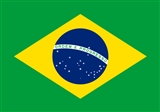
. It is the world's fifth largest country, both by geographical area and by population with over 192 million people. It is the only Portuguese-speaking country in the Americas
and the largest lusophone
country in the world.
Bounded by the Atlantic Ocean
on the east, Brazil has a coastline of 7491 km (4,655 mi).
1500 Vicente Yáñez Pinzón becomes the first European to set foot on Brazil.
1500 The fleet of Pedro Alvares Cabral leaves Lisbon for the Indies. The fleet will discover Brazil which lies within boundaries granted to Portugal in the Treaty of Tordesillas.
1500 Portuguese navigator Pedro Álvares Cabral becomes the first European to sight Brazil.
1549 The city of Salvador da Bahia, the first capital of Brazil, is founded.
1551 The foundation day in Vitória, Brazil
1554 Founding of São Paulo city, Brazil.
1573 The Brazilian city of Niterói is founded.
1695 Zumbi, the last of the leaders of Quilombo dos Palmares in early Brazil, is executed.
1812 The USS ''Constitution'' under the command of Captain William Bainbridge, captures the HMS Java off the coast of Brazil after a three hour battle.
1815 Foundation of Maceió in Brazil.

